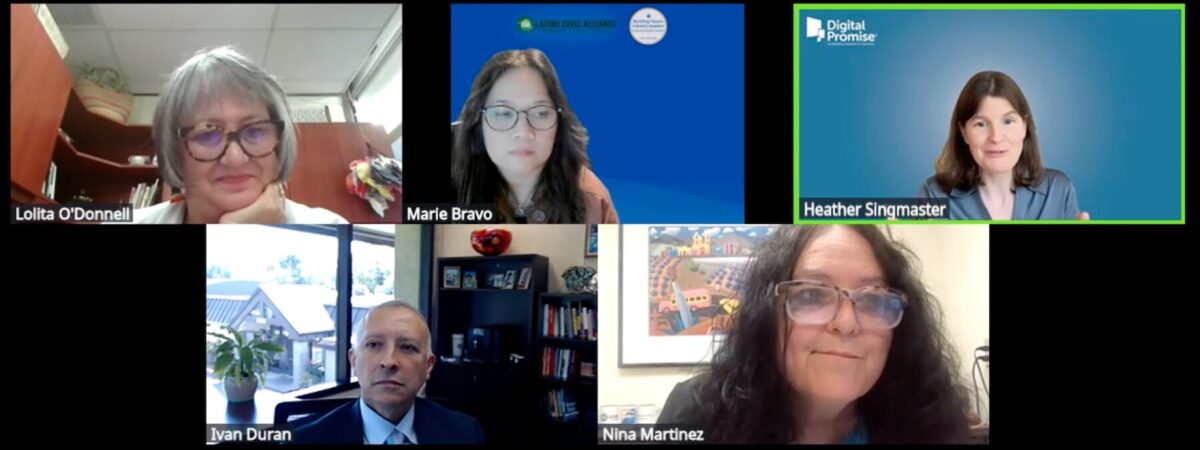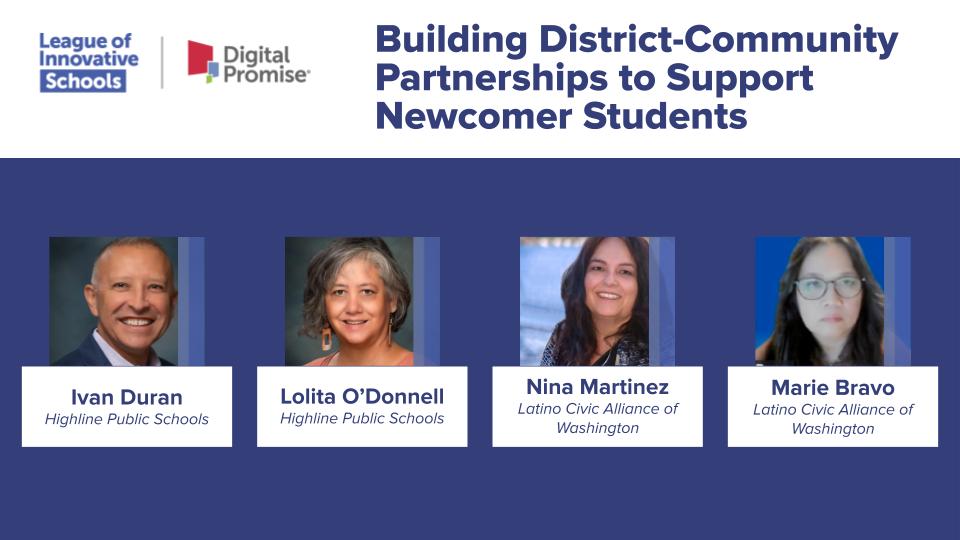
The third and final session on May 21, “Building District-Community Partnerships to Support Newcomer Students,” specifically focused on how education leaders can build strong partnerships with community organizations to create a holistic support system for newcomer students both in and out of the classroom.
To explore this topic through concrete examples, the Digital Promise team invited leaders from League of Innovative Schools member district Highline Public Schools in the Seattle, Washington area, and the Latino Civic Alliance of Washington to share insights into what has made their partnership effective.
Below, we share three key takeaways that district and school leaders can leverage to help ensure newcomer students and families in their communities receive the wraparound support they need.

Highline Public Schools is an extremely diverse district made up of more than 17,000 students, 31% of whom speak a first language other than English. For Superintendent Ivan Duran, this diversity underscores the importance of Highline Public Schools’ mission to know each of its students by “name, strength, and need.” This value is of particular importance when it comes to supporting newcomer students.
Understanding individual students starts with recognizing the immense contributions newcomer families bring to the community. “We know that newcomer students bring so much to us—rich traditions, languages, and perspectives, and they help to foster global awareness,” Superintendent Duran shared.
Highline Public Schools’ ability to recognize and understand these contributions is a direct result of its investment in a clear, consistent family engagement strategy.
“We have to rethink how our students experience education,” Superintendent Duran shared. “[We’re] going into our community, working with students, working with families, and really asking them, ‘What are the experiences that you want for your students?’”
According to Lolita O’Donnell, director of family and community partnerships at Highline Public Schools, a key way in which the district prioritizes family and community engagement is through its four family and community engagement specialists, a dedicated team of leaders who regularly connect with students and families to ensure that, “they have a pulse on what’s happening in schools.”
Beyond this team, the district taps diverse voices across school communities to help shape the district’s offerings and support systems for newcomers. Highline’s superintendent student leadership team, for example, meets weekly with district leadership to share their experiences, perspectives, and ideas. The district also works closely with bilingual community liaisons and co-designs partnerships and programs alongside families to ensure all voices are heard and incorporated into their initiatives.
When it comes to the district’s partnership philosophy, building strong relationships with families is a central focus, and Highline taps community partners, like the Latino Civic Alliance of Washington, to help reinforce and foster those relationships. “Highline is excellent at family engagement,” Nina Martinez, executive director of the Latino Civic Alliance of Washington, shared. “They have a strong commitment to [connecting] with parents.”
For Highline Public Schools, strong partnerships have been critical to providing vital support systems to newcomer students and families.
“We cannot do this alone,” O’Donnell shared. The district has worked to forge more than 80 community partnerships over the years.
O’Donnell recommends districts begin their process for establishing newcomer student support by “resource mapping” their area to understand which partners have a strong presence in, and are trusted by, the community.
In identifying its own partners, Highline leverages an asset mapping process to also ensure values alignment between the district and the prospective partner. Values alignment with partners goes hand-in-hand with strong relationships, both of which are embodied by the partnership between Highline and the Latino Civic Alliance of Washington. The two officially joined forces in 2020 amidst the COVID-19 pandemic to provide testing, supplies, and resources to families as well as social emotional learning for students, at a time when students and families were more difficult to reach. Because the Latino Civic Alliance works directly with families in homes, they were able to build connections between families and the district in ways that would not have been possible otherwise.
“This was a partnership that really felt meaningful,” Martinez shared. “In a time of crisis, you see organizations coming together that share the same values.”
“We have built and gained trust with the community. That is why they come to us for support,” emphasized Maria Bravo, resource development director at the Latino Civic Alliance of Washington.
Once a new, values-aligned partner is identified, districts should establish an onboarding process to ensure consistency and efficacy. Highline Public Schools, for example, follows an eight-step process that includes elements like meeting with the school principal and district staff, filling out a partnership agreement template, submitting a certificate of liability insurance, and sharing necessary paperwork with district team members.
O’Donnell also reiterated the importance of continuous improvement of partnerships, which critically involves “going out and seeing the work.” “Relationships, collaboration, and really understanding student needs,” are all key to ensuring that partnerships are effective and deliver the right support systems for newcomer students.
While establishing a strong partnership helps set-up vital support systems for newcomer students and families, communicating about its success helps ensure its sustainability.
Consistent, public-facing communication of partnership successes is extremely important to Highline Public Schools, as demonstrated by its real-time partnership dashboard, which makes information on each of its partnerships publicly available. The benefits of this reporting are three-fold: it can serve as a resource to other districts and organizations in the area who are seeking partnerships; it makes this information readily available to district families and the broader community; and it helps to ensure that specific partnerships are delivering on shared goals.
Highline’s partners also have opportunities to speak at the district’s monthly board meetings, during which time they share details on their work within the community and with the district and speak directly to successes and lessons learned.
Strong communication also exists internally within and across schools and partners. The main goal of these internal communications is to provide schools, the district, and partners with a thorough, shared understanding of the various supports that individual newcomer students are receiving so that the services don’t feel fragmented to students or families.
Are you interested in gaining additional resources and hands-on experience around supporting newcomer students?